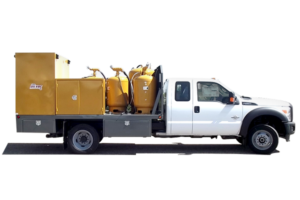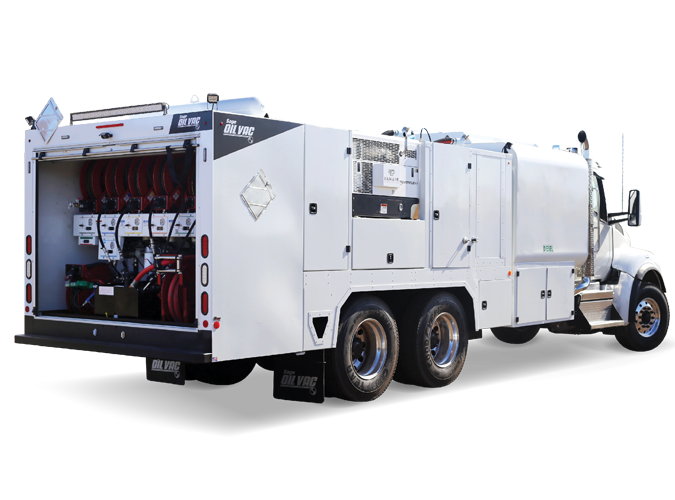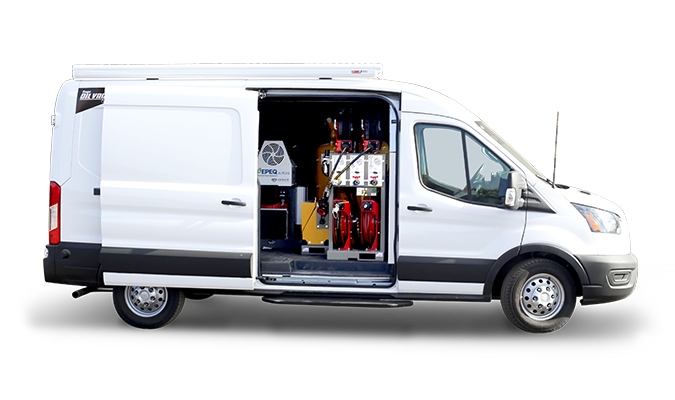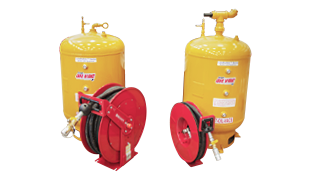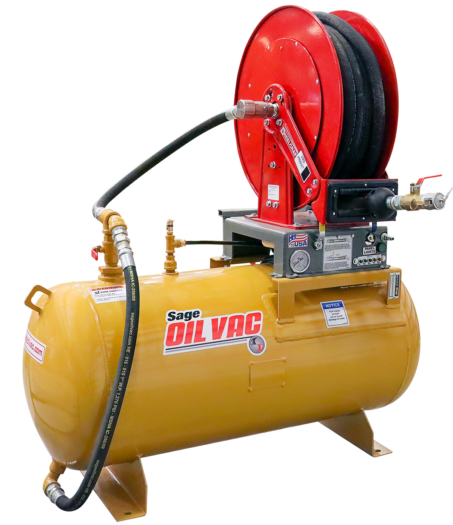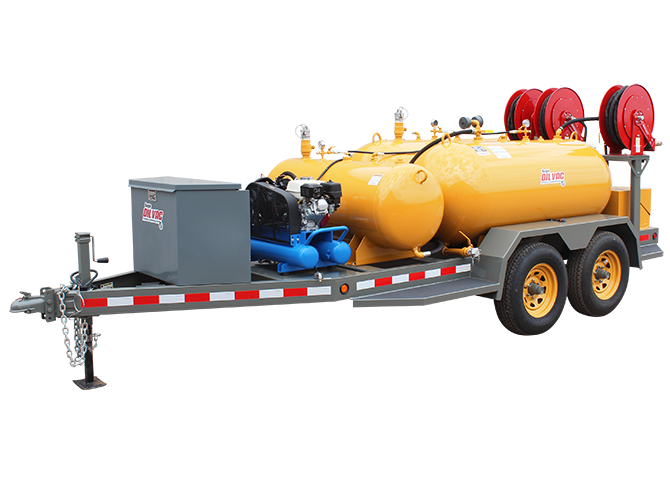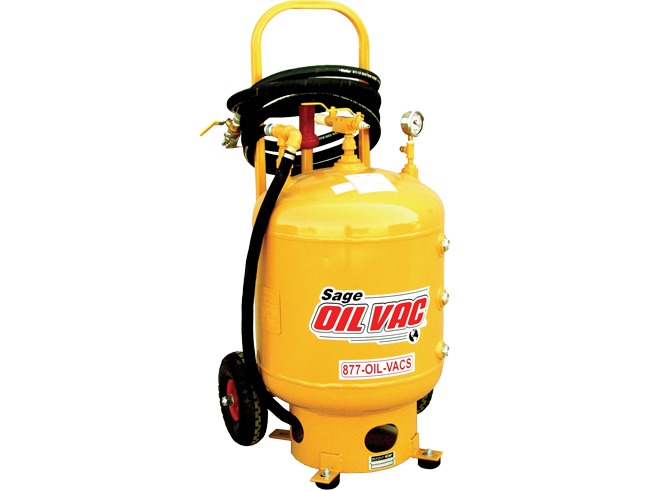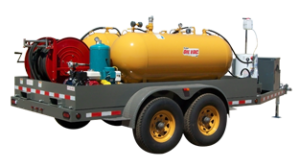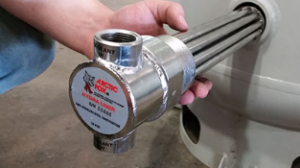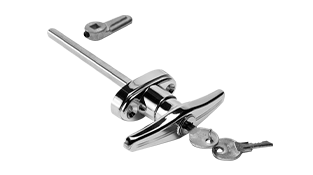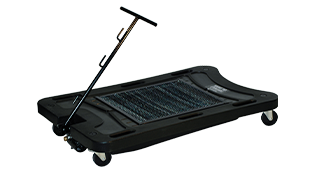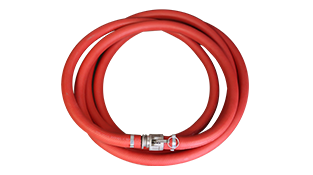
The Sage Oil Vac team will be at the Work Truck Show in Indianapolis, Indiana next week. Visit us in booth #3067 in the Exhibit Hall where we will be showcasing:
- Our redesigned Lube Truck
- With a variety of tank combinations, all oil tanks utilize the Sage Oil Vac exclusive pressure and vacuum system to load fresh fluid tanks.
- Class 5, 7 and 8 options available.
- All tanks are fitted with a float and pressure gauge that is displayed on the remote panel, informing the user of vacuum/pressure levels captured in the tank, as well as the current fluid level.
- Heritage Lube Skids
- The Heritage skid design features built-in forklift-friendly transport and has plenty of capability for large fleet services.
- The patented Sage Oil Vac Vacuum process is used to load fresh fluid.
- A favorite of work trucks, the vertical tank design gives it a small footprint.
- NextLube Monitoring System
- The intuitive touchscreen controls provide real-time fluid levels and displays gallons of fresh fluids available.
- The central, easy-to-use control panel allows the operator to label tanks for better fluid organization.
The four-day show is the must-attend event for the work truck industry. The Sage team is committed to keeping up with the ever-changing needs of our customers. We work closely with manufacturers to bring you improved maintenance technology with our revolutionary mobile lube exchange systems, customization options and accessories.
For more information about the Work Truck Show or to register to attend, visit worktruckshow.com.
Evolving customer needs, a changing workforce and new technology are changing the marketplace for fuel and lube trucks.
“Our customers are working in a different world than they were just a few years ago. Between the chassis redesign, features and technology, we’re devoting a lot of resources to keeping up with what they need,” said Sage Oil Vac CEO Aaron Sage. “Construction companies spend hundreds of thousands of dollars on fuel and oil, and we want to make sure we’re helping them do their job serving their customers.”
A newly redesigned lineup of Sage Oil Vac lube trucks directly addresses operator concerns and provides the tools and technology to help operators make the most efficient use of their time. The new trucks — non-CDL models (Class 6), as well as Class 7 and 8 — not only help operators work more efficiently, but add tools that help them better meet the needs of those operating the machinery they’re servicing. The new trucks come at a time when changes in the workforce are creating challenges for machinery maintenance service providers around the country.
Industry demographics
One of the changing industry dynamics driving the evolution in lube and fuel service trucks exemplified by the new lineup of Sage non-CDL (Class 6), Class 7 and 8 trucks lies in permitting. There are fewer operators today obtaining a commercial driver’s license (CDL) than in past generations. And, the labor market for those with CDLs is so tight today, it makes it difficult for construction contractors and service technicians to find adequate qualified operators with the licenses required to operate the larger Class 7 or 8 trucks. That makes the revamped non-CDL lube truck popular, Sage said, because managers can more efficiently manage the same amount of work with a smaller, less-expensive truck.
“It’s harder to find CDL drivers, so a lot of companies — especially in the oil fields in West Texas — are looking for non-CDL applications. So, if you’re looking for a lube-only truck, these non-CDL trucks can help meet the same need without that license,” Sage said of the trucks that are built on either a Ford F-600 and Chevrolet 6500 pickup. “A lot of the big OEM dealers are using these trucks for oil, but not fuel, to conduct maintenance for rental fleet customers.”
Redesigned body
There’s an aesthetic shift in the new Sage lube trucks, but it’s not just about good looks. The new design includes panels and components to provide more solid, seamless coverage of the tools and materials the trucks are transporting. Gone are the days when a driver pulls up behind a Sage lube truck will see buckets, tools and other components that are common at jobsites. In addition to helping provide dealers the ability to better promote their businesses, the new design goes even further to promote the cleanest possible jobsite and prevent possible issues with spills that can sometimes attract punitive regulatory attention.
“You don’t see all the equipment and oil, and we do that for two reasons: First, the more you can make these trucks look nice and better shield oil and tools from view, the better,” Sage said. “And many of these OEM dealers are selling service, so they want to put a wrap or decal across the entire side of the truck with their name on it to maximize their brand’s visibility. These better-covered trucks with more seamless designs make it easier to do that.”
Managing weight
Another component of the redesign of Sage Oil Vac’s lube trucks adds efficiency by better-managing weight, a common issue for operators who sometimes face both regulatory and supply management issues with heavy lube trucks. The new Sage trucks integrate more aluminum into the chassis and components, while shifting some parts and components to different locations helps better balance overall weight across the front and rear axles.
“Weight is always a challenge, so we redesigned these trucks to optimize weight for a better center of gravity. And, we’re building more items out of aluminum for weight savings,” Sage said. “There is a lot more aluminum going into these trucks and other machinery across the industry. I think the market is more accepting of it. We are using steel where we need steel and aluminum where we need aluminum.”
Efficiency through technology
On top of the Sage pressure and vacuum delivery system that eliminates diaphragm and piston pumps — common sources for maintenance work and cost — the new lube trucks help operators work more efficiently by integrating new technology that helps better track and manage maintenance performed. Via a touchscreen monitor, the operator can track how much fluid and/or fuel is being distributed to each machine on a jobsite, eliminating a step in the process and adding efficiency. This technology that’s rapidly advancing will continue to evolve to help operators work efficiently in the field.
“Operators can assign or record gallons of fluids, then dump it onto a USB drive or CSV file to enable the customer to get live reporting,” Sage said. “You can see how much fuel and oil you’re distributing to each piece of equipment. It especially really helps larger OEM dealers work more efficiently since they don’t have to go around a jobsite and ask machine operators if they need fuel or oil. It takes that step out of the process.”
Learn more about Sage Oil Vac lube trucks and bodies. Have more questions or want to find your nearest Sage Oil Vac dealer? Contact us!
Sage Oil Vac has been servicing large fleets in Texas and New Mexico’s oil and gas energy industry that rely on generators. Generators are used for new site construction, pumping units, powering water wells, as well as for dozens of other activities. In fact, at many sites, generators run 24 hours a day, seven days a week and the expert energy operations call on when they need power is Big D Companies of Midland, Texas.
For over 40 years, the team at Big D Companies has been servicing large fleets while delivering a wide range of services, including generator rentals, open pit lining, polyethylene pipe installation, fencing and construction services. In total, Big D Construction delivers fast and reliable service to a 200 square mile territory, and operates a fleet of equipment that includes more than 100 earthmoving machines, over 330 generators and 500 miles of polyethylene pipe.
Huge maintenance needs
On any given day, Big D Companies has between 200 and 300 generators ranging in size from 20 kW to 1MW out on-rent to contractors across two states. Most of those units run around the clock, which creates short service intervals for the Big D Construction service team.
According to Trey Villanueva, operations manager for equipment rentals at Big D Companies, the company has a team of 17 people dedicated to servicing large fleets and rented equipment. “This team is responsible for providing transfer pumps to feed water trucks, supplying generators to power the water wells that feed frack pits and servicing machines out on rent,” he explained. “It’s a big job because we need to perform oil changes on most of our generator fleet every 10 to 12 days, so we try to be as diligent as possible at hitting those intervals to keep our customers up and running.”
To efficiently service the large fleet of generators in the field, Big D Equipment’s service team use Sage Oil Vac mobile lube equipment. The company owns three Sage Oil Vac 1C5G-5100 mobile lube trailers with four 60-gallon (227 liter) ASME tanks for fresh oil and fluid and one 120-gallon (454 liter) ASME tank for used oil, as well as five Sage Oil Vac lube skids that are truck mounted.
“We started with one small Sage Oil Vac lube skid and when we saw how much more efficient it was than the old way we serviced machines in the field, we added additional units until we had enough to service our whole fleet,” explained Villanueva. “We use our truck-mounted units to perform routine maintenance on generators near our offices in Midland and Pecos, Texas. Since our trailer lube systems can carry such a large volume of fresh fluid, we use those units in more remote locations and jobsites in New Mexico. Our guys can usually stay out in the field for up to three days without having to come back to the shop to refill or drain used oil — that’s a huge savings in time and travel expenses.”
Old way versus new way
Until Big D Companies invested in its first Sage Oil Vac mobile lube system around four years ago, the service team was using impeller pumps and one gallon (3.79 liter) oil containers in the field. “On average, two service techs would spend between 45 minutes to an hour changing the oil on each generator,” explained Villanueva. “They would have to pump out the used oil into buckets, replenish the oil and then transfer the used oil into sealed containers so they could be hauled back to the shop for disposal. Not only was it time-consuming and labor intensive, it was also a messy process.”

Making the switch to Sage Oil Vac mobile lube systems cut servicing time for their large fleets down to15 to 20 minutes per generator. This increase in efficiency made it possible for them to double the number of oil changes they can do each day and eliminated the need to send a second person out on routine maintenance trips. This combination has had a dramatic impact on Big D Companies maintenance expenses.
The cost-savings didn’t stop there; Villanueva explained they used to buy oil in cases because they were easier for service technicians to handle. However, now they can reap the benefits of purchasing the same Chevron oil in bulk at substantial savings. “Every day, our service technicians would have to load three to four boxes of oil onto the back of their trucks because they didn’t have a way of dispensing oil other than pouring it through a funnel,” he said. “We were paying between $16 to $18 a gallon with our old setup. With Sage Oil Vac mobile lube systems, we can quickly load our tanks from larger barrels, which is much easier and it has driven down our prices to as little as $10 a gallon. In just one year, we’ve been able to save around $12,500 on oil. The savings have been huge for us.”
The impeller pumps that Big D Companies service team used previously had a limited operational life and required routine maintenance. The company’s first Sage Oil Vac mobile lube system is still going strong and hasn’t needed much maintenance other than a few filter changes in four years. “Impeller pumps aren’t costly, but we would go through a lot of them. When they broke down on a service call, things took much longer,” added Villanueva. “Our first Sage Oil Vac mobile lube skid has been mounted on three different trucks since we purchased it. On average, we put around 250,000 miles on our trucks before replacing them. This unit has traveled more than 750,000 miles and has been almost completely trouble free, servicing a larger fleet than ever before.”
Keeping it clean
Another benefit of using a mobile lube system the team at Big D Construction and their customers appreciate is the cleanliness of the whole service process. Big D Companies has replaced its fleet factory-made drain plugs with Sage Oil Vac Femco® drain plugs, which allows the suction hose of the waste oil tank to connect directly to the oil pan of the machine without having to remove the plug. “Draining and refilling machines is easier and cleaner,” said Villanueva. “The equipment being serviced, our vehicles and our technicians all stay clean in the process. We’re able to reduce the chance of any kind of oil spilling, which helps us come across even more professional in the eyes of our customers.”
Satisfied customers best benefit of all
The team at Big D Companies knows their reputation is on the line every time a generator goes out on rent. Their customers’ operations depend on those machines to run around the clock and are acutely aware anytime they’re not. When they aren’t servicing their large fleet of equipment, they are focusing on serving their customers. Diligent preventative maintenance is the key to reducing downtime and maximizing the life of a machine, which is why Villanueva and his team’s efforts are so important to Big D Companies overall operations.
“Our president, Don Tomlin, started Big D Construction under the principle of creating economic value for our customers and ourselves by identifying new and better ways of working. Making the switch to Sage Oil Vac mobile lube systems for routine in-the-field equipment maintenance delivers value to our customers and our organization. What’s more, our initial investment was quickly recouped through cost and labor savings. It has been a win for everyone involved,” Villanueva concluded.
Learn more about Sage Oil Vac’s mobile lube systems and other ways we can help you service your fleet.
We’ve got your back! Sage Oil Vac has launched a new, three-tier warranty program (effective September 2018) to better serve customers near and far.
Why the update?
After an analysis of more than 25 years of successful Sage Oil Vac equipment lifecycles, we determined that the quality and reliability of our products continue to exceed expectations. This has encouraged us to enhance our warranty program from the previous two-year, flat warranty to a three-tier, five-year warranty program.
“This updated warranty plan further benefits customers and better positions Sage Oil Vac as a leader in the lube exchange marketplace,” said Kyle Ottmers, Sage Oil Vac Warranty Manager. “Should you invest in a Sage system, you’ll have added peace of mind with this new warranty. We’re here to support you in the off chance that something goes wrong.”
PREVIOUS TWO-YEAR, FLAT WARRANTY |
NEW THREE-TIER WARRANTY PROGRAM |
|---|---|
Items covered for the first two years:
|
Items covered for the first five years:
Items covered for the first two years:
Items covered for the first year:
|
Download our warranty policy document for a complete list of details and exclusions, then take advantage of the new policy by filling out an equipment warranty registration form for your Sage Oil Vac system.
Contact Sage Oil Vac or email Kyle Ottmers with questions about your qualifying equipment at [email protected].
We talk about our Sage Oil Vac LubeBuilder system a lot, not just because we want to show you how it works, but because we know how much it is impacting the people and businesses that use it. How do we know? Because the companies that buy it tell us. One such example is the Johnson-Davis Inc. team based in Lantana, Florida.
>> Learn more about the LubeBuilder System.
In order for you to know why a LubeBuilder a la carte fluid exchange system works well for Johnson-Davis, you first need to know who they are, what they do and a little bit about their growing pains. After all, their story might sound like yours.

Johnson-Davis is an underground utility contractor founded by Herb Johnson with his sons in 1977. The company started with humble beginnings in Herb’s garage, and now its workload and backlog, demands an equipment fleet to support more than 15 mainline crews plus punchout crews.
Big construction jobs like storm drainage systems, sanitary sewer and water main construction require big equipment. And with big equipment requires big maintenance needs. No one knows this better than their Shop Manager Michael Llewellyn.
“Due to project demands, we regularly have large equipment pieces spread across a large part of Florida. That includes equipment like backhoes, loaders and pumps from Florida’s Miami-Dade to Orange counties,” Llewellyn said. “We do about 95 percent of our own maintenance, and our three service trucks were becoming stretched thin. Since the equipment is the lifeblood to our operations, we have to give it the required attention.”

“We were looking for a solution when we heard about the LubeBuilder System from Jason Heim at Linder Industrial,” Llewellyn said. “Since they work with quality industrial machinery brands like Komatsu and Atlas, we took their recommendation seriously.”
Llewellyn was able to work with their local Sage Oil Vac dealer ACME Truck Body to purchase the exact lube exchange components needed to improve their smaller equipment maintenance programs.
“The process was easy. I gave ACME our tank sizes and what we wanted, and they took it from there,” Llewellyn said.
Llewellyn then received blueprints to approve and after a few minor tweaks, ACME sent in the order. The order took three weeks to arrive and two weeks for ACME to install into the chassis of a new box truck.
The Johnson-Davis LubeBuilder System kit included:
- (1) 120-gallon waste oil tank
- (3) 30-gallon fresh oil tanks
- (1) 60-gallon fresh oil tank
- 50-ft. reels on all tanks
- 8 HP electric start compressor
- 50-ft. air reel
 The Johnson-Davis team has been making good use of all their LubeBuilder system so far.
The Johnson-Davis team has been making good use of all their LubeBuilder system so far.
“The Sage Oil Vac system within our LubeBuilder has been especially helpful when it is time to change fluids,” Llewellyn said. “We encounter a lot of algae contamination in our fuel tanks because of our geographic area which can be easily removed with Sage’s vacuum technology.”
>> Read: Are You Doing It Wrong? How to Get a Cleaner Oil Exchange.
Plus, now that more new equipment is using DEF fluid, the operations team has enjoyed having a dedicated DEF fluid tank on board.
“Now we have a way to easily top off equipment using one of our LubeBuilder tanks as a dedicated DEF tank,” Llewellyn said. “This helps to prevent contamination.”
>> Find your local Sage Oil Vac dealer for a free LubeBuilder System quote and blueprint.
Used oil buckets are strewn about the back of a truck. Containers piled high. Tipped over oil jugs rolling around with peeling labels. This chaotic imagery keeps the Sage Oil Vac team awake at night and it has them asking one question: How do people work with a mobile truck system setup like that?
“We see unorganized work trucks on the road all the time and it’s become kind of a competition among the Sage team to capture a photo of the worst offenders,” said Chance Castillo, Sage Oil Vac Midwest Territory Manager. “I just want to flag them down and say, ‘There’s a better way!’”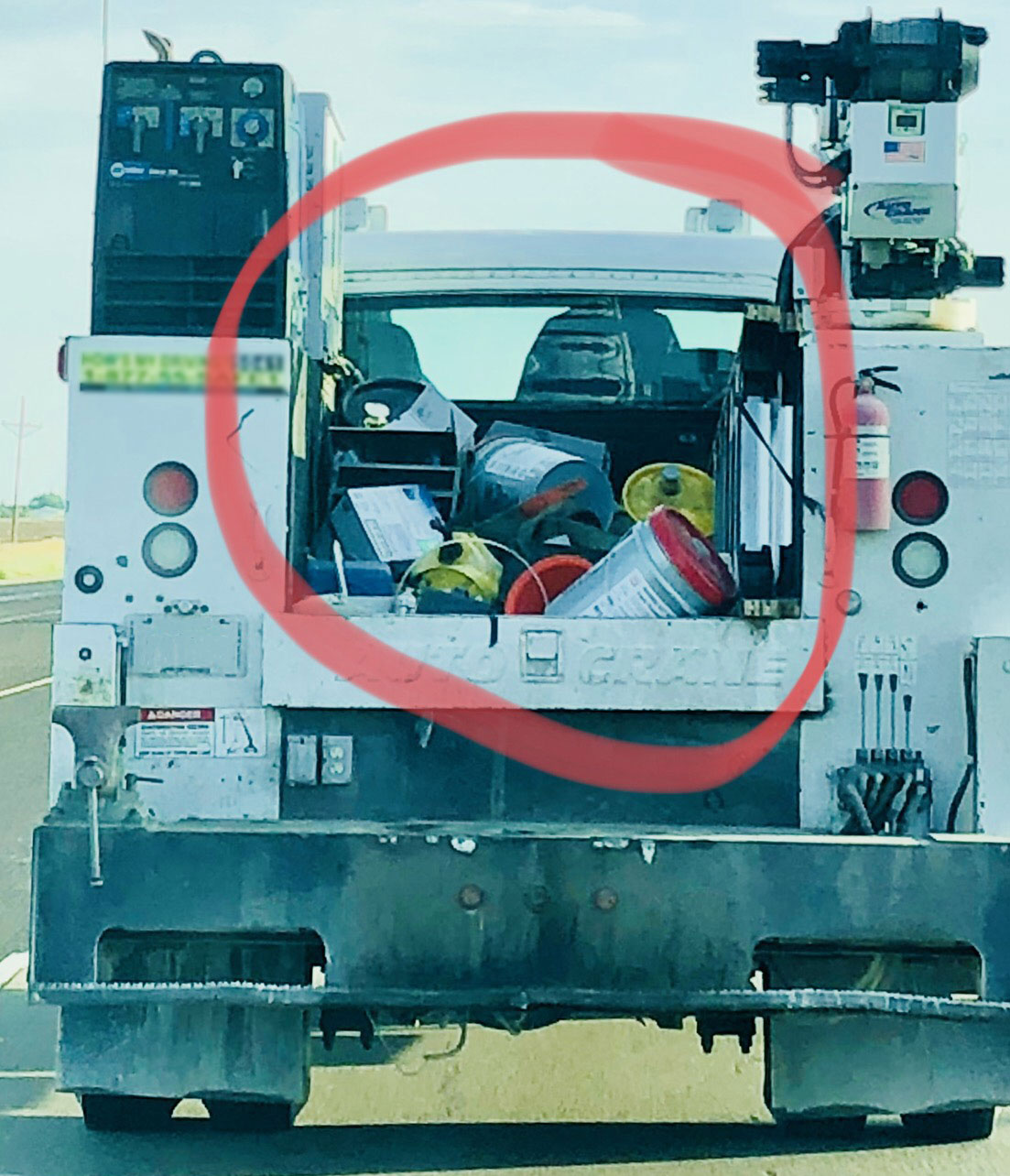
Right about now you’re probably thinking: What is this “better way” and how expensive is it to revamp your mobile truck system setup? Well, Castillo says it’s their game-changing LubeBuilderTM system.
Elevate your mobile service truck setup
As a completely customizable, a la carte lube system for virtually any vehicle, the LubeBuilder system cuts costs by allowing the customer to select only the things they really want and need. Choose everything from the number of tanks, tank storage capacities and the placement of the tanks within the space you have available. This product works great for crane trucks, mechanics bodies, van bodies and enclosed bodies.
“This system isn’t just great for organization, a few common situations we see are when a pre-built lube skid’s footprint doesn’t fit, a customer can’t afford to get another dedicated truck, or a lube trailer doesn’t work with the jobsite parameters they frequently visit,” Castillo said. “Whatever the reason, a LubeBuilder™ system provides operators with the lube exchange essentials to fit their exact set-up at a fraction of the cost.”
Order a LubeBuilder™ system
The ordering process is incredibly simple as well. Customers work with a Sage specialist at their local dealer or they can contact Sage Oil Vac directly. After the initial call or email you will receive a price quote – and at the customer’s request – Sage will even provide a custom blueprint to help you visualize the layout of your mobile service truck setup for installation planning.
“Our dealers and Sage specialists try to make the whole process as seamless as possible,” Castillo said. “Our end goal is to make the customer happy and improve jobsite effectiveness. We’re very thorough in our follow-ups to make sure your final LubeBuilder set-up is what you envisioned it would be.”
Once the order is placed, the team in Amarillo packages the parts you need within a short two- to three-week lead time. Your LubeBuilder kit will then arrive with everything you need to complete the install yourself — we’re talking the tools, the step-by-step instructions and every nut, bolt and screw. Sage Oil Vac even has an installation video you can watch if you prefer video instructions. Depending on your mechanical proficiency and system size — Castillo said it takes most customers a few days to have the whole install completed (sometimes less depending on how many helping hands you have).
“The LubeBuilder concept can be hard for some people to understand because we have no physical inventory to show them,” Castillo explained. “Since everything is 100 percent custom to your needs, there are no two kits alike unless someone has ordered a whole fleet of kits for identical vehicles. So, since most dealers don’t have an example to show you in-store, we want to emphasize how transdecent this product is — it’s a mobile lube exchange solution that can be anything you need it to be.”
Sage Oil Vac is here for you
Castillo also stressed that if a photo of your current mobile truck system could make the “Sage Wall of Shame,” there’s no judgement if you give them a call.
“Step one is accepting there is a better solution than your current setup and step two is coming to Sage Oil Vac for the LubeBuilder system solution. We’re here to help and this is a safe space,” Castillo joked. “We like to think that the reason some of these trucks look the way they do is because the company hasn’t heard about the LubeBuilder system yet or they don’t know how affordable it is.”
If you or someone you know drives a disorganized lube vehicle similar to the photo above, call the Sage Oil Vac support hotline or contact your local dealer for a fast, free LubeBuilder quote today.
Perth, Australia is one of the world’s most isolated capital cities. Home to over 2 million people, Perth is famous for its capital wealth and extravagant beaches. Australia is the world’s top exporter of iron ore, gas and gold, most of which is found in Western Australia. Thus, it was once said Perth was home to more self-made billionaires than any other city in the world.
Amarillo, Texas, is the largest city in the Texas Panhandle. Home to approximately 200,000 people, Amarillo was once the self-proclaimed “Helium Capital of the World” for having one of America’s most productive helium fields. Each year thousands upon thousands of travelers driving along U.S. Highway 66 stop off at the Big Texan Steak Ranch to watch would-be heroes take on the legendary 72 oz Steak Challenge.
In other words, these two places couldn’t be more different. One connection is the Sage Oil Vac system. For over 10 years, Sage Oil Vac equipment has crossed the Pacific Ocean en route to Oil Vac Australia, where manager Jon Lamb and his team provide superior maintenance solutions for a variety of industries such as agriculture, construction and mining.
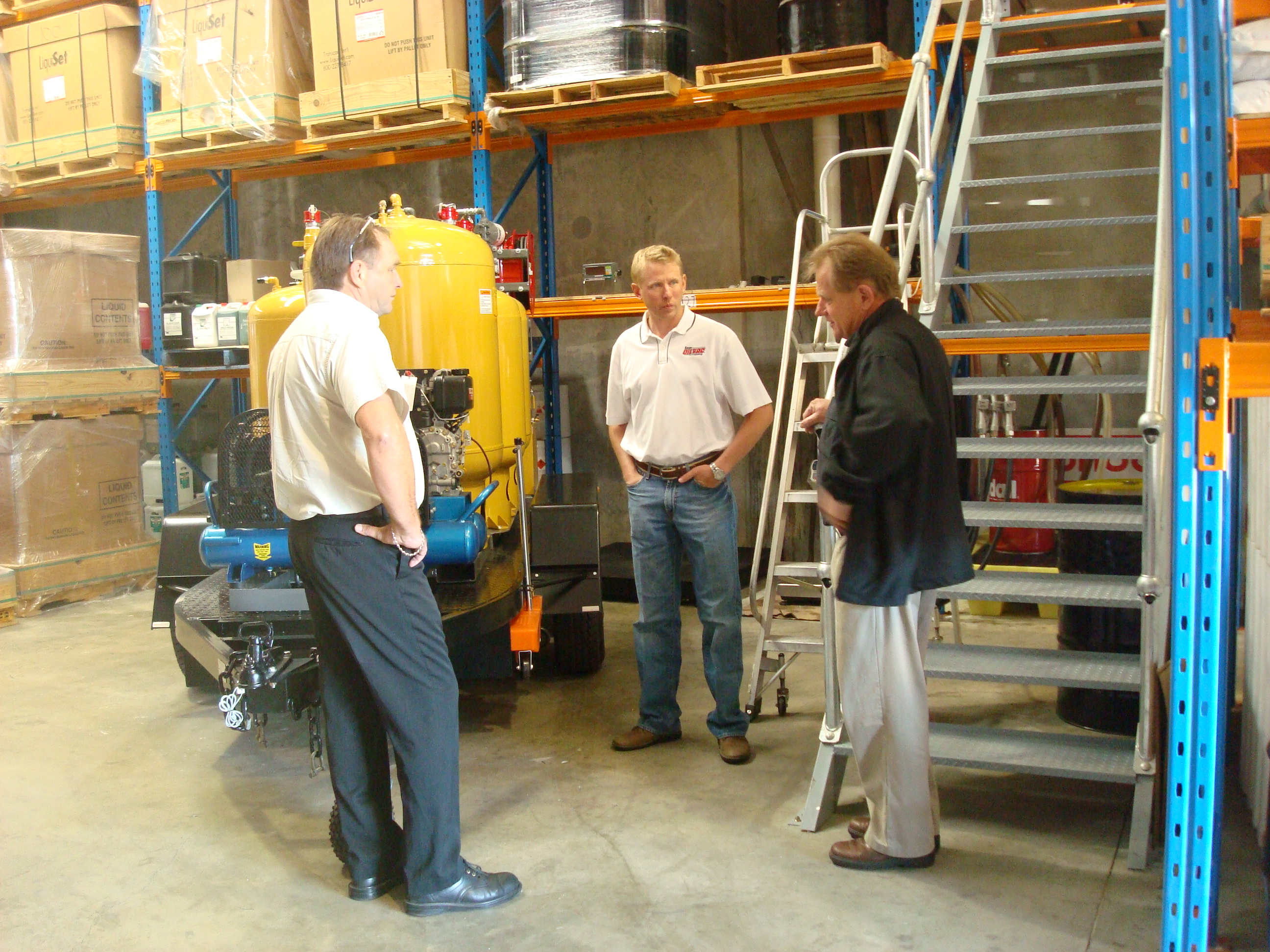
But how did this partnership come to be? Well, with a 13-hour time difference and a five- to seven-week lead time on product shipments, it didn’t happen overnight. Through a series of marketing partnerships, Sage Oil Vac founder Gary Sage and current CEO Aaron Sage met with Colin Wootton and Ron Kossen in 2002 to talk business. The latter two own and operate OIL and Energy PTY LTD, a company that hosts one of Australia’s most comprehensive lubricants distribution portfolios. So, they know a thing or two about the lube exchange process. “Resource extraction and mining are significant contributors to Australia’s economy — iron ore and coal are by far the largest exports,” explained Aaron Sage. “With big mining operations comes heavy-duty mining equipment like bulldozers, excavators and loaders; that meant there was a need for our fluid exchange system whether they knew it yet or not.”

After a few years of relationship building, Wootton and Kossen were ready to bring the Sage Oil Vac systems to Australia. After all, what better way to gain more oil customers than to also offer a premier lubricant exchange system?
In 2008, Lamb was sent to Texas in order to become an expert on Sage Oil Vac equipment, gaining the knowledge and expertise needed to set up shop in Australia.
“I’ll never forget when I met with Gary Sage for the first time; he said to me: ‘This will be the hardest thing you will ever sell,’” Lamb recalled. “And Gary was right. Most of our competitors use the old-fashioned pump systems and that was all that our customers knew. Using compressed air instead of a pump was a new idea for our customers, so it took some convincing.”
Lamb put in a lot of time on the ground setting up demonstrations with his connections in the mining industry — and his perseverance paid off. He said his focus on the health, safety and environmental factors, coupled with the general time-savings benefits of Sage Oil Vac equipment, really hit home with his customer base. Plus, Aaron gave him a little added motivation.
“Aaron made the commitment to me that if I could sell 100 units, he would buy me a pair of Beck cowboy boots which are made in Amarillo,” Lamb said.
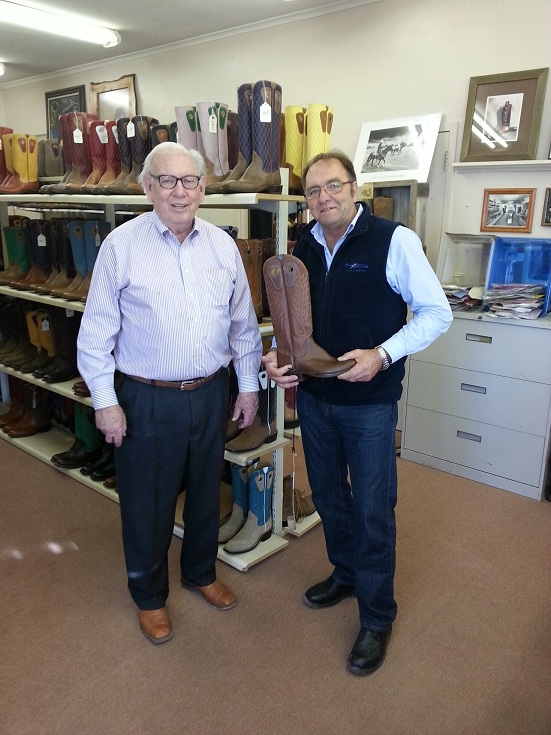 The 100-unit goal was surpassed nearly five years ago. To date, Lamb has sold close to 250 Sage Oil Vac units. His biggest product sellers are LubeBuilder systems, trailers and skids.
The 100-unit goal was surpassed nearly five years ago. To date, Lamb has sold close to 250 Sage Oil Vac units. His biggest product sellers are LubeBuilder systems, trailers and skids.
The Oil Vac Australia customer base includes a broad spectrum of industries. Their units are now being used by world-leading oil and gas resource companies such as BHP, Rio Tinto, Glencore; service and equipment supply companies such as Coates Hire, WesTrac, Cummins South Pacific and Komatsu Australia; and by local farmers who perform their own agricultural equipment maintenance.
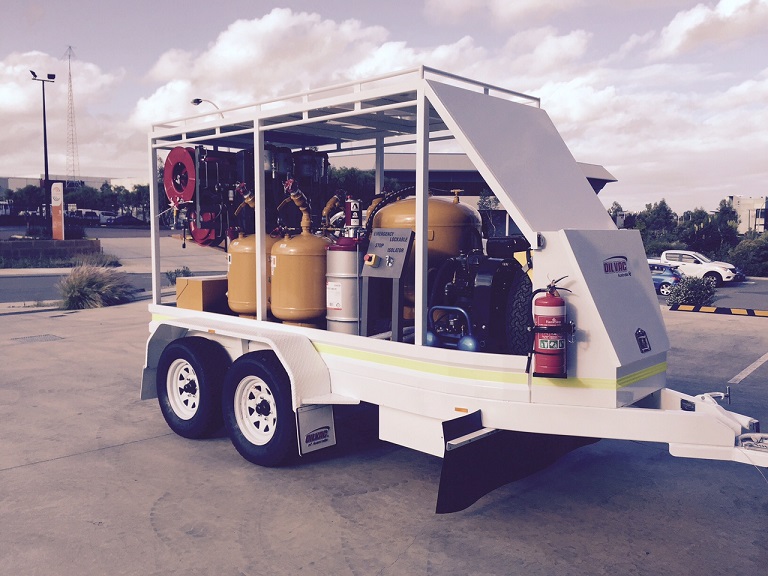
“Over here, people do like to work with their own people to create their custom service trucks, so I often work with about nine or 10 custom fabrication companies to create Sage Oil Vac and make sure they get their Lubebuilder kits to set everything up,” Lamb explained. “The Sage Oil Vac systems have proven themselves to be faster, safer and especially cleaner, time and time again. It might have been a hard sell at first, like Gary said, but now it’s much easier now that people are more aware of the brand.”
As for the boot wager, Aaron was more than happy to come across with a nice pair of Becks to celebrate the accomplishment.
“Jon earned those boots tenfold — Oil Vac Australia’s success comes from his ability to relate to the customers through his hands-on knowledge, and through his demonstrations showing the equipment’s application adaptability,” Aaron said. “He has tremendous credibility with some of the largest mining operations on the planet. I have always said that Jon knows the Sage Oil Vac product and can demonstrate it just as well as Gary Sage or any other principal at Sage Oil Vac.”
If you’re interested in becoming a Sage Oil Vac dealer in your area, please contact Sage Oil Vac for more information.
Clean oil is a thing of beauty and starting with a pure product (especially oil that’s OEM-approved) can be nearly impossible if your operation doesn’t have the right set up to prevent oil contamination during the exchange. While all motor oils eventually succumb to contamination and need to be changed due to day-to-day exposures, there are several factors that could be mucking up your pure product sooner than planned. Sage Oil Vac CEO Aaron Sage has seen it all, and he’s here to help with a little sage advice.
Preventing oil contamination
Problem: The oil is dirty upon arrival
It happens all the time — the new oil shows up from the distributor and it’s less than pristine. Or maybe you can’t see it’s dirty at all and you only find out later when your equipment is running subpar.
Sage Oil Vac Solution: “Over the years we’ve seen firsthand that new oil doesn’t always come clean from its distributor — that’s why Sage Oil Vac equipment comes standard with built-in filtration systems,” Aaron said. “That added protection can really be the differentiator in a quality oil exchange.”
The built-in filtration systems within Sage Oil Vac equipment acts as a strainer for harmful particles providing an added safety net against oil contamination.
Problem: The “Fly-By-the-Seat-of-Your-Pants” oil organization system
Picture this… oil jugs rolling around in the back of the truck, labels falling off, misplaced caps, half-empty containers and few used oil buckets sloshing around. It’s oil contamination galore. Does this sound familiar?
Sage Oil Vac Solution: “Things can go haywire quick if you’re not organized — we’ve seen operators put the wrong oil in because they’ve got a bunch of drums and buckets laying around and the labels got worn off,” Aaron said. “We’ve created professional lube equipment with the features like our NextLube monitor system to help operators maintain efficiency on the jobsite and cut down maintenance costs.”
The NextLube monitor allows operators to integrate data while incorporating automation and fluid control as an optional add on accessory for Sage Oil Vac lube trucks and trailers. The monitor allows operators to label tanks for better fluid organization and uses intuitive touch screen controls with real-time fluid level displays and more.
Problem: Meeting OEM warranty requirements
Some OEMs require specific oil to be used in their equipment as a part of their warranty agreements. Sometimes the warranty agreement will be part-specific too, so one oil type needs to go in the motor and another type needs to go into the hydraulics.
Sage Oil Vac Solution: “We can, and we have, added extra tanks to help accommodate this kind of thing,” Aaron said. “It’s better to be prepared with the right oil exchange set up throughout equipment warranty periods. If something goes wrong and breaks down and you didn’t follow the rules, you might be out of luck and have to pay out of pocket.”
Sage can help you customize a dedicated lube vehicle for these situations with our LubeBuilder system. Choose everything from the number of tanks, tank storage capacities and the placement of the tanks within the truck bed. Your custom LubeBuilder kit will arrive with installation instructions and manuals for a simple install.
Problem: Traditional lube equipment
Using a proper storage tank is essential in avoiding oil contamination to prolong the life of the lubricant. Depending on your current equipment, you could be mucking up your clean oil supply with a dirty tank.
Sage Oil Vac Solution: “In traditional lube equipment they use an atmospheric tank — we’ve been to customers’ sites where we’ve pulled the cap off and there’s an inch of caked oil and dirt in the bottom,” Aaron said. “With our system, we have sealed tanks and built-in filtrations to keep fluids clean.”
Sage exchange systems use clean, sealed tanks which reduces oil contaminants (and creates less spillage on the job). While the Sage system goes against the grain of the traditional pump-based technology, customers who make the switch enjoy a cleaner, more energy efficient oil change on the job. The unique pump-free design allows the end-user to dispense and drain oil faster using cutting-edge vacuum technology.
Find more information on the many advantages of Sage Oil Vac or find your local dealer.
The construction industry is a hardworking, fast-paced and safety-conscious enterprise filled with constant change and innovation, but no one knows that better than the team at CL Boyd. CL Boyd is a three location, John Deere construction equipment dealership based in Oklahoma City, Oklahoma with over a century of experience.
“CL Boyd has been around since 1913, so that means we have over 100-plus years in the construction equipment business,” said CL Boyd Service Manager, Dwight Nix. “We sell and service all types of construction equipment.”
With this long history in the industry, one can only imagine the steady and endless stream of maintenance jobs and oil changes the CL Boyd crew completes every year. So, it’s no surprise they’re constantly looking for efficiencies. Enter Sage Oil Vac.
CL Boyd is currently using Sage Oil Vac equipment in three forms throughout their operation. They have several installed LubeBuilder systems with 60-gallon tanks, a Heritage Lube Skid within a utility truck and a custom stationary shop vac system that features a 1200-gallon waste capacity.
“Before we installed the Sage shop system, we just had a large waste tank located outside of our building and a big container that we would fill with used fluid,” said CL Boyd Shop Foreman, Andrew Troutman. “Then, when the container was full we would roll that out across our parking lot to dump it into the holding tank. We would have to drag a big air tank and hose out there too to evacuate it.”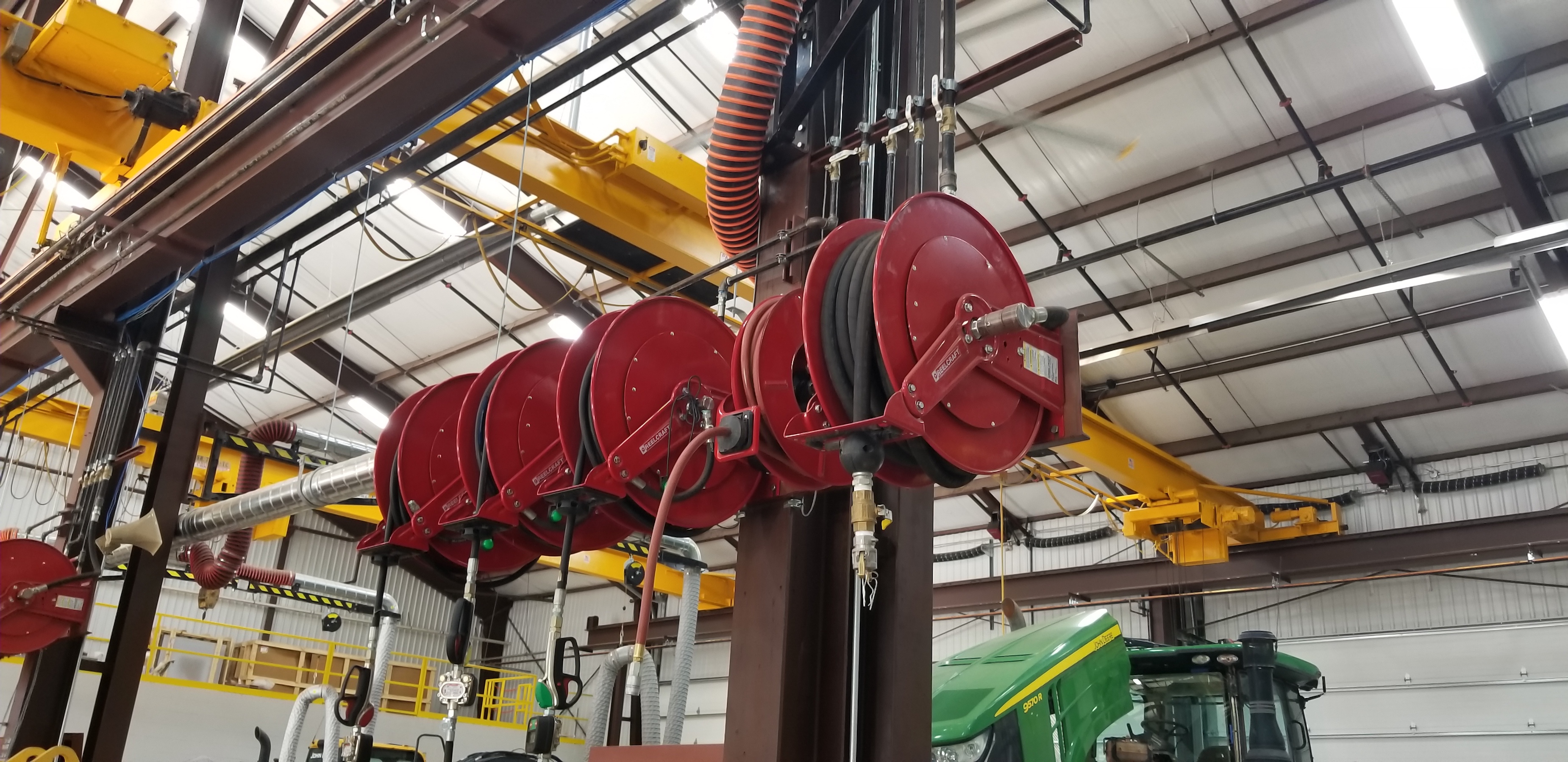
Nix said the old way was about as conducive as it sounded.
“What you’d get stuck with was a waste oil tank that was always full — someone would go to grab it to use it and it would be full because the last guy didn’t want to go through the work to take it outside and empty it,” Nix explained.
The CL Boyd team now uses smaller Sage Lube Carts to evacuate oil, then they empty those into their custom Sage Shop Vac system that has been piped along the ceiling of their shops. The system uses two holding tanks for waste within the maintenance area with hoses and reels located at every bay.
“Now, the technicians don’t have to leave their bay to empty waste oil,” Nix said.
Additional efficiencies have been found with their Heritage Lube Skid, which can hold up to 240 gallons of new and used oil in four separate product tanks – Giving their team the capability to vacuum used oil when out in the field.
“Our Heritage Skid allows us to execute multiple equipment services, without having to carry buckets and buckets of oil on a truck,” Nix said. “Plus, it’s nice to be able to suck up the waste oil on the spot. It’s got a hose reel and nozzle right there, so you can just transfer it directly into the machine as opposed to pouring into jugs and through funnels and all that kind of stuff.”
With their previous lube exchange system, Nix said there was often excess new oil left over from a job which created waste.

“The Heritage skid makes it a lot easier — we can pump the exact amount of oil we need,” Nix said. “If it requires 17 quarts we can do that as opposed to using three 5-gallon buckets and a 2.5-gallon jug and then having oil left over.”
Nix said he’s also looking forward to installing more LubeBuilder systems onto company service trucks. CL Boyd’s custom system came with two 60-gallon used oil tanks which allows them to vacuum used oil when they’re out on a jobsite.
“In February of this year, we installed our first LubeBuilder system on one of our main service trucks, and everybody has preferred that set up over the old system that we used to use,” Nix said. “I think we have four systems installed now. Our old way used diaphragm pumps which were kind of slow and we ended up having issues with those.”
With three established locations in Oklahoma; Oklahoma City, Ardmore and Lawton. Nix said the CL Boyd team has plans for more Sage Oil Vac products down the road.
“We plan to phase in more LubeBuilder systems as we continue to upgrade our service truck fleet,” Nix said. “We like the simplicity and the oil level controls using Sage Oil Vac and the fact they use compressed air, not pumps.”
For more information about Sage Oil Vac products and customization capabilities, contact us today or find your local dealer.
It has been one year since Lester Contracting in Port Lavaca, Texas, entered and won Sage Oil Vac’s first-ever Lube Skid Sweepstakes contest which ran during the 2017 CONEXPO-CON/AGG show in Las Vegas.
As the sweepstakes winner, Lester Contracting was able to select the Sage Oil Vac lube skid model of their choice (they went with a 2H48-5 Heritage Lube skid) for a yearlong demo. Their 2H48-5 lube skid was also customized to their specifications — it featured a 120-gallon used oil tank, four 60-gallon fresh oil tanks, five 50-foot reels and a grease package all within an enclosed trailer.
“It has been awesome to have the opportunity to win something like this and learn that we’re able to do (large-scale fluid exchanges) on our own,” said Brandt Boone, Equipment Manager of Lester Contracting. “In terms of cost and time — we know (the 2H48-5) helps the company and we appreciate Sage giving us this opportunity.”
Lester Contracting has served the surrounding areas of South Texas as a civil contractor since 1959. Their primary services include dirt work and utilities, such as water and sewer.
“Our company is made up of mainly Caterpillar equipment from backhoes to excavators, wheel loaders and dozers,” Boone said. “We have probably 60-70 pieces of Caterpillar equipment. We also have a fleet of trucks — Mack trucks, dump trucks and a few 18-wheeler belly dump trucks.”
Before Lester Contracting received their demo skid from Sage, their mechanic team did most of the smaller preventative maintenance jobs in-house at their facilities. The larger scale PM’s, that occurred every 2,000 to 6,000 hours needed equipment with much larger fluid capacities than the company could handle. As a result, those PM’s had to be outsourced to Caterpillar to complete.
“I saw the cost of (outsourcing) was really adding up and I wanted to find a way to reduce that cost and take care of it in-house with our guys,” Boone said. “(With the 2H48-5) my mechanics are able to do those large-scale PM’s, something we weren’t able to do before.”
Now that the demo year is up, Boone says they plan on purchasing the 2H48-5 because it not only “makes sense” to keep it, but his team enjoys the efficiency of the system. All Sage Oil Vac skid models feature Sage’s signature pump-free fluid exchange technology which use compressed air to build vacuum pressure to move fluids to and from tanks. Fresh oils and fluids can be vacuumed at a rate of up to 10-15 gallons per minute (gpm). Removing pumps from the equation means fewer maintenance problems and a lower cost of ownership.
“The guys really like it,” Boone said. “They work together to get the oil change done and (the 2H48-5) is quick, hassle-free and clean — I like that it’s clean with no spillage. It’s an efficient system and that’s what they appreciated about it.”
Sage equipment uses clean, sealed tanks and an enclosed vacuum system to significantly reduce the possibility of the fresh fluid contamination. This configuration also protects the operator and the environment as tanks are not vented to the atmosphere and spillage is reduced and localized.
Boone also said the enclosed trailer option made the 2H48-5 very portable so they could travel from jobsite to jobsite with ease.
“It’s been great. I’ve been able to observe the mechanical team a couple times on oil changes (with the Sage skid) and they make it look really easy whenever they’re going through the motions of completing an oil change.” Boone said. “I just think it’s really quick, easy and clean; and I’m sure it saves us time versus having somebody else come in and do it.”
Are you ready to change with Sage? Contact us or your local dealer.

